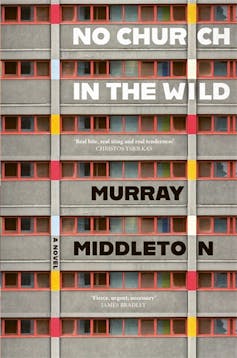
Before commencing Murray Middleton’s new novel – the follow-up to his Vogel Award-winning debut When There’s No Where Else to Run (2015) – some readers might be taken aback by the title, which evokes a song of the same name.
The lyrics of No Church in the Wild, which opens Jay-Z and Kanye West’s celebrated 2011 album Watch the Throne, describe struggles between a “mob” and a “king”, and a “king” and a “God”.
Struggle is implicit in a title that opposes a place of worship with a wilderness, invoking the division between the sacred and the profane. Tellingly, though, the church is not in the wild, its absence suggesting that Middleton’s fiction is concerned with things that are missing: tolerance, supportive institutions, shared beliefs, even grace.
Review: No Church in the Wild – Murray Middleton (Picador)
Set in Melbourne, No Church in the Wild chronicles the lives of disadvantaged young immigrants. Three foregrounded institutions – police, education, housing – are all failing the boys at the centre of the novel. Ali, Walid and Tyler live in decaying housing commission towers; they are misunderstood by their teachers and demonised by the authorities.
The novel’s opening scene, not unlike West and Jay-Z’s music, is both memorable and unsettling, depicting a clash between police and African youths:
The cops have been hanging around the flats for months, doing slow circles of the car park in unmarked Holdens, getting Afros to empty their pockets on the half-court…
The scene invokes the infamous Melbourne tower-block lockdown during the height of the COVID pandemic, an episode that sparked a debate over the racial profiling of immigrants. Indeed, racial profiling is threaded through a novel that is deeply concerned with the question of how prejudice colours perception. As an omnipresent force, prejudice is seen to arise, interestingly, from characters’ insecurities, as they forge a sense of self through the denunciation of others.

Tyler, for example, is a young Turkish student who lives like an orphan due to his mother’s drug habit and his father’s criminal past. He dreams of becoming a soldier – a fantasy that involves dehumanising his enemies as Afghani “goatherders who marry their sisters”.
Similarly, Constable Paul, whose beat is the brutalist housing commission towers, expresses contempt for “avo-eating lefties” and “social justice warriors”. The cliches, both tiresome and instructive, validate his conservatism, germane to a police culture that, historically, has had no place for bleeding-heart sentimentality.
But it is the ordinary experience of racism that most bothers Ali, an aspiring rapper. He observes his friends Hassan and Walid enduring daily indignities on Melbourne trams, as strangers show their displeasure at having to sit next to the black kids.
The mundane character of everyday racism is depicted as perhaps the most damaging of all. Middleton’s narrative emphasises how individuals and communities lose their sense of worth, as the dominant culture undermines their identity through repeated acts of rudeness and disdain.
Two jungles
At school, the boys’ teacher, Anna, struggles to control a classroom full of dissonant personalities who have emigrated from such far-flung lands as Somalia, Turkey and Vietnam – some of them arriving, tellingly, via Manus Island. During one lesson Anna is kissed by her student Musa (as a dare), while another student mouths the lyrics to West and Jay-Z’s No Church in the Wild.
The classroom scenes evoke Richard Brooks’ classic film The Blackboard Jungle. But the form of No Church in the Wild perhaps has more in common with David Simon’s police drama The Wire, which explores urban life from the perspectives of the police, drug dealers, political figures and educators who have to endure it. Like The Wire, Middleton’s novel develops multiple points of view, inhabiting the different perspectives of its key characters, showing how they dwell within and across entwined sectors of society.
For example, when we access policeman Paul’s interiority, he comes across as a cynic and a critic, but also as someone capable of compassion. The latter attribute is revealed when he realises his younger brother Davey is not the deadbeat he thought, but someone struggling with depression. Schoolteacher Anna, who is embarrassed by their one night stand, perceives Paul as a cocky cop – a judgement shared by her student Ali, who sees Paul as a “hero” in his “own life”.
In truth, none of these perceptions are accurate. Between them, they reveal a chasm between characters and their worldviews.
The turning point of the novel comes when a joint initiative by the school and police to help troubled youths offers Ali, Tyler and Walid a unique opportunity: an expedition to Kokoda. From the outset, the program is undercut by the idea that it is a token form of atonement for the pervasive racism they face, little more than a cynical exercise in assuaging white guilt. As Ali’s school friend Musa astutely observes:
…they beat the shit out of us and then they offer some suckers a free holiday every year to say sorry … but they never wanna actually say sorry. I don’t get it. Saying sorry is heaps cheaper.
The Kokoda project turns out to be not so much about helping “disengaged” non-anglo youths, as inculcating the values of the Anzac legend. “Courage, endurance, mateship and sacrifice”: the police involved drum the meaning of these words into Ali, Tyler and Walid. But the attempted initiation fails to resonate, especially with Tyler, whose countrymen were historically on the opposing side. “I was just thinking it’s weird,” he observes. “In Gallipoli, we were pretty much enemies.”
The Kokoda trek is largely experienced as a dream. It is refracted through the perspectives of the lead characters, who rise to its physical and mental challenges. Anna, in particular, appreciates the strange beauty of the landscape, while imagining the cruelties it offered 80 years before:
The wild pumpkins, the giant wild knuckles of the tree roots, the slippery log crossings and the mud-sucking trail, which must’ve felt like the final gruelling frontier for Japanese soldiers before the bounty of the Australian mainland.
This actual wilderness, and the stark contrast it provides to the urban wilderness of Melbourne’s housing estates, provides a temporary sense of freedom. In the jungle, ideology is momentarily suspended: each character catches a glimpse of the eternal in a resilient nature that precedes and exceeds us all.
It is uncertain whether this moment of redemption survives the Papua New Guinean jungle. What is certain is that the barbaric wasteland is not in nature, but in our urban centres, communities, and even our minds. The latter is most poignantly revealed through Tyler, whose poverty and lack of parental support leave him hungry for material and spiritual sustenance.
A wilderness of sorrow
Middleton’s use of multiple points of view, modernist in origin, has at least one famous Australian precedent in Randolph Stow’s Visitants (1979), a masterful collage of perspectives that eschews a single dominant narrator.
Middleton may not have quite the same poetic sensibility as Stow, but his prose becomes vibrant and dynamic whenever it is channelled through Tyler’s searing point of view. There are moments of brilliance, such as when a stoned Tyler attends an RSL club and scathingly observes its patrons:
Some seriously old couple have just arrived, wearing clothes from five hundred years ago. The dude’s face is basically halfway between a human and a zombie’s, like a messed-up truth is stuck inside it.
No Church in the Wild is meticulous in its use of slang to evoke its urban milieu. But Middleton’s style can also be oblique and indirect, in way that fits well with his narrative approach:
Paul hurls the pigskin into the air. Kids in red and blue bibs chase it in every direction, misjudging the bobble of the rock-hard turf.
The careful language is at times reminiscent of Toni Morrison’s Beloved (1987), which develops a style that inhabits the emotional lives of her protagonists, capturing the horrendous ways in which slavery dehumanised and murdered African Americans, and evoking a wilderness of sorrow that cannot be fathomed or atoned.
A wilderness of sorrow also permeates No Church in the Wild, which is shadowed by injustices and grievances that remain unatoned, including the death of a young African man, who is taken and beaten by police and is later found drowned. It is unclear whether the death is a murder, suicide or an accident.
The uncertainty leaves open the wound of racism. The tragedy becomes one of the many things in the novel left unresolved – a faithful reflection of a reality that is full omissions and injustices (especially when minority deaths in custody are concerned).
No Church in the Wild is a bold novel that crosses cultural and institutional boundaries. It covers much ground in its exploration of key sectors in society that are integral to our wellbeing, yet vulnerable to dysfunction. The scope of Middleton’s imagination is impressive. At times, the execution of his ideas falls short of his ambition, but No Church in the Wild sheds valuable light on contemporary Australia. It prompts readers to question their own ethics and values, especially with respect to the poor, the racially marginalised and the disenfranchised. Such questioning is urgent in Australia, where empathy and compassion so often remain fringe concepts in public debate.
Suzie Gibson does not work for, consult, own shares in or receive funding from any company or organisation that would benefit from this article, and has disclosed no relevant affiliations beyond their academic appointment.
This article was originally published on The Conversation. Read the original article.







